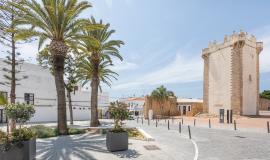General information

Enjoy Conil knowing about its fishing history
This route, of great historical and cultural interest due to the fishing origins of Conil, covers different points of interest that relate the sea to the origins and growth of the municipality:
- Mesón Ducal - La Tahona: known as the Mesón del Duque, it was built around 1580 by the Duke of Medina Sidonia, outside the walls, in Calle la Virgen number 3, to provide accommodation for merchants who came to buy tuna from the tuna trap. Throughout its history it has been an inn, a grocery shop, a tavern, a bakery and a neighbourhood courtyard.
- The food market: it is a building of contemporary architecture (1995-2002). Here you can buy not only fresh fish that has passed through the fish market, but also different local products from the market garden or meat products.
- Torre de Guzmán: this was the first building in Conil and gave its name to the municipality until the 16th century. It dates from the late Middle Ages (14th-15th centuries) and was built by Don Alfonso Pérez de Guzmán el Bueno. The dukes used the castle as accommodation during the tuna fishing season, to supervise everything personally. Nowadays it can be visited to enjoy unbeatable views.
- La Chanca: it houses the Interpretation and Documentation Centre of the Sea, the Tuna and the Almadrabas. A unique enclave in which the development and importance of the Atlantic Bluefin Tuna fishing activity can be understood. The great increase in tuna fishing encouraged the Duke of Medina Sidonia to build between 1540 and 1560, a group of buildings with a double purpose: to serve as a salting factory and a warehouse for the boats and equipment of the traps.
- Chapel of the Holy Spirit: it was built on a site donated by the Duke of Medina Sidonia where there used to be a watchtower for spotting tuna. In the 1940s it was used to store fishing equipment, and it recovered its religious use in the 1960s. In its belfry is the oldest bell in Conil, dating from 1632. The Virgen del Carmen, patron saint of fishermen and sailors, is worshipped in this chapel, which is why it is located in the "Barrio de los pescadores" (fishermen's quarter).
- The Fishermen's Quarter: of great ethnological interest for being a place that has preserved the fishing essence of the town. Its streets are narrow and in them you can see traditional patios with pots of typical flowers such as geraniums, wells that years ago were used collectively, and neat white facades. Undoubtedly a place where you can experience Conil from its origins.
- Mirador de Jabiguero: This viewpoint is located on a cliff from where you can enjoy the beauty of the beaches and their sunsets. The monument that presides over it pays homage to the fishing history of Conil by simulating a fisherman in typical costume pulling the seine, a seine net and shooting gear that had a great development in Andalusia.
- Castilnovo Tower: Originally it was a small fortress with an artillery piece to defend the coast and its traps. An enclosure was built around it, the perimeter of which can still be seen today, which served as accommodation for both the tuna trap workers and the merchants who came to buy the tuna. The fortress had a mayor with voice and vote in the town council of Conil, and remained in force until the Lisbon earthquake of 1755, which caused a tidal wave that destroyed it, leaving only the Castilnovo Tower. Near the tower is one of the two monoliths that were used to set the buche trap. At present, a colony of Eremita ibis, an endangered bird that has recently been introduced in the region of La Janda as part of a recovery plan, has nested on its roof.
- Almadraba markings: these are coastal markings that served as a reference to set the Almadraba de Conil box in place. Five of these markings are conserved in Conil, two next to the Castilnovo tower, one in the same town, the Atalaya viewpoint, and another two in Cabo Roche.
- Fishing port of Cabo Roche and La Lonja: The port is currently home to a fishing fleet of more than fifty operational fishing vessels dedicated to various artisanal modalities. Thanks to the construction of the harbour and the La Lonja building in the 80's, the fishing sector has undergone a great evolution. Visiting the fishing port and La Lonja is to connect with the fish gastronomy of the coast from the very beginning.
- Viewpoint of Cabo Roche: The viewpoint, located next to the Roche Lighthouse, offers privileged views of the fishing port, the coast from Conil to Barbate with its cliffs, and on clear days you can see the coast of Africa. It is also an ideal spot for bird and cetacean watching. The Roche lighthouse formed part of the system of coastal watchtowers ordered to be built by Felipe II in the 16th century to defend the Spanish coast.
- Torre del Puerco: not only did it form part of the watchtowers built by Philip II in the 16th century, but it also served as a watchtower for almadrabas and jábegas, as it is believed that a chanca once existed nearby.
Contact
Our location
Interesting data
Telephone
Address
Torre Castilnovo, 11140, Conil de la Frontera, Andalucía, Cádiz, ES
Email
turismo@coni.org
How to get
















Add new comment